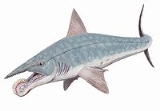
Eugeneodontida
Encyclopedia
Eugeneodontida is an extinct and poorly known order of bizarre shark
s. They possessed a unique "tooth-whorl" on the symphysis
of the lower jaw as well as pectoral fins supported by long radials. The palatoquadrate
was either fused to the skull or reduced. It is possible that they may belong to Holocephali
.
Shark
Sharks are a type of fish with a full cartilaginous skeleton and a highly streamlined body. The earliest known sharks date from more than 420 million years ago....
s. They possessed a unique "tooth-whorl" on the symphysis
Symphysis
A symphysis is a fibrocartilaginous fusion between two bones. It is a type of cartilaginous joint, specifically a secondary cartilaginous joint.1.A symphysis is an amphiarthrosis, a slightly movable joint.2.A growing together of parts or structures...
of the lower jaw as well as pectoral fins supported by long radials. The palatoquadrate
Palatoquadrate
In some fishes, the palatoquadrate is the dorsal component of the mandibular arch, the ventral one being Meckel's cartilage....
was either fused to the skull or reduced. It is possible that they may belong to Holocephali
Holocephali
The subclass Holocephali is a taxon of cartilaginous fish, of which the order Chimaeriformes is the only surviving group.Holocephali has an extensive fossil record that starts during the Devonian period. However, most fossils are teeth, and the body forms of numerous species are not known, or, at...
.
Taxonomy
- Superfamily Caseodontoidea
- Genus CampodusCampodusCampodus is an extinct genus of eugeneodontid from the Carboniferous....
- Genus Chiastodus
- Family Caseodontidae
- Family Eugeneodontidae
- Genus Bobbodus
- Genus Eugeneodus
- Genus Gilliodus
- Genus Campodus
- Superfamily Edestoidea
- Family AgassizodontidaeAgassizodontidaeThe Agassizodontidae are an extinct and poorly known family of bizarre sharks. They possessed a unique "tooth-whorl" on the symphysis of the lower jaw as well as pectoral fins supported by long radials.-External links:* at paleos.com** at Denovian Times...
- Genus Agassizodus
- Genus Arpagodus
- Genus Campyloprion
- Genus HelicoprionHelicoprionHelicoprion was a long-lived genus of shark-like cartilaginous fish that first arose in the oceans of the late Carboniferous , survived the Permian-Triassic Extinction Event, and eventually went extinct during the early Triassic some ....
- Genus ParahelicoprionParahelicoprionParahelicoprion is an extinct genus of eugeneodontid, shark-like cartilaginous fish....
- Genus SarcoprionSarcoprionSarcoprion is an extinct genus of cartilaginous fish from the Permian of Greenland....
- Genus Toxoprion
- Family EdestidaeEdestidaeEdestidae is an extinct and poorly known family of sharks. They possessed a unique "tooth-whorl" on the symphysis of the lower jaw as well as pectoral fins supported by long radials. The palatoquadrate was either fused to the skull or reduced. It is possible that they may belong to...
- Genus EdestusEdestusEdestus is a genus of shark that lived throughout the world's oceans during the late Carboniferous. All of the species are known only from their teeth...
- Genus Helicampodus
- Genus Listracanthus
- Genus Lestrodus
- Genus Metaxyacanthus
- Genus Parahelicampodus
- Genus Physonemus
- Genus Prospiraxis
- Genus Syntomodus
- Genus Edestus
- Family Agassizodontidae

